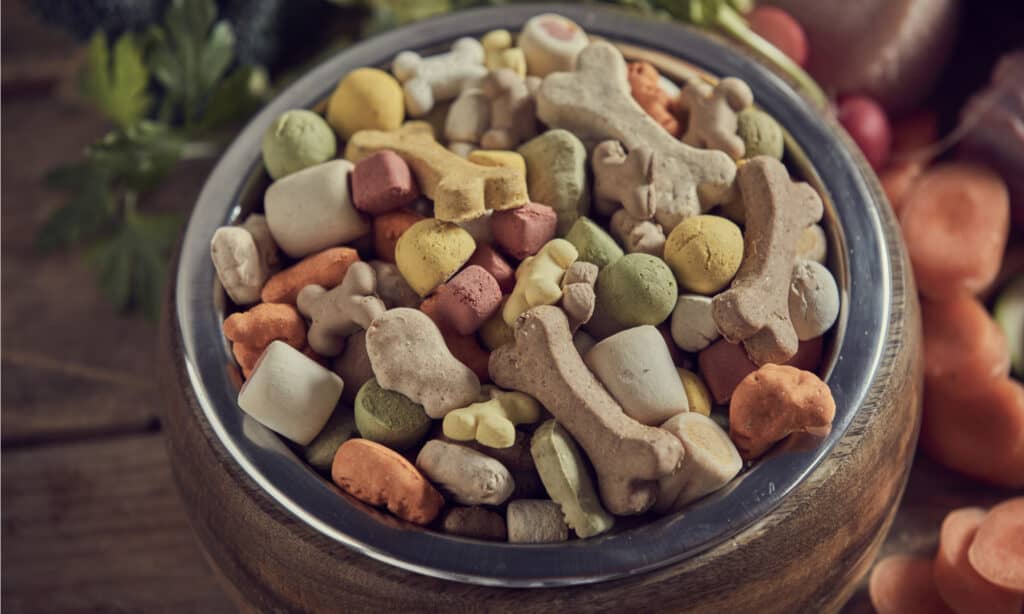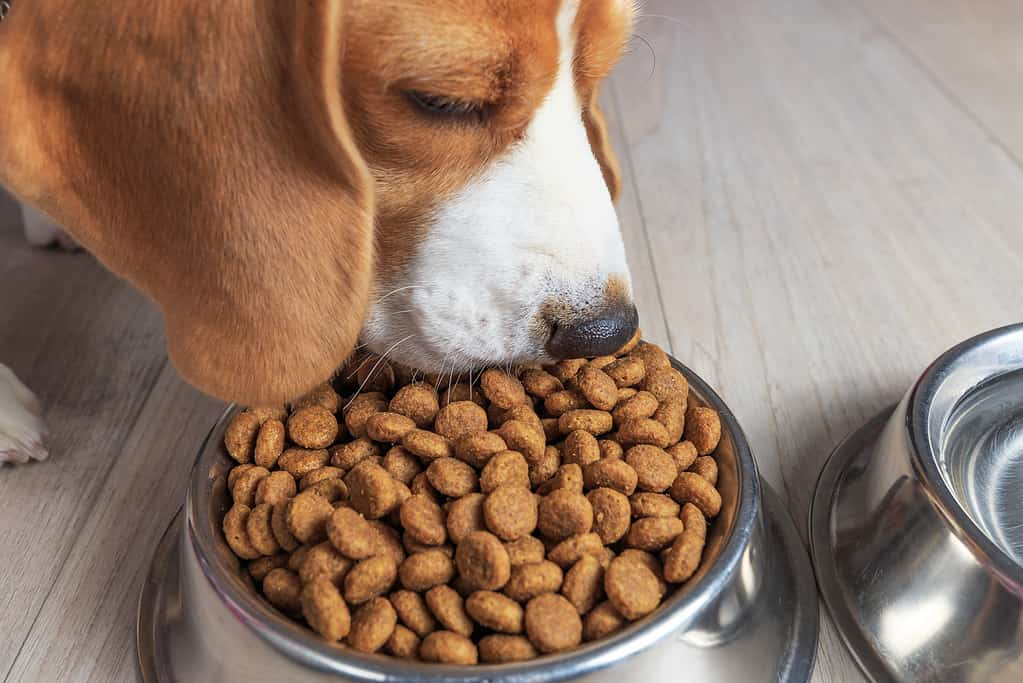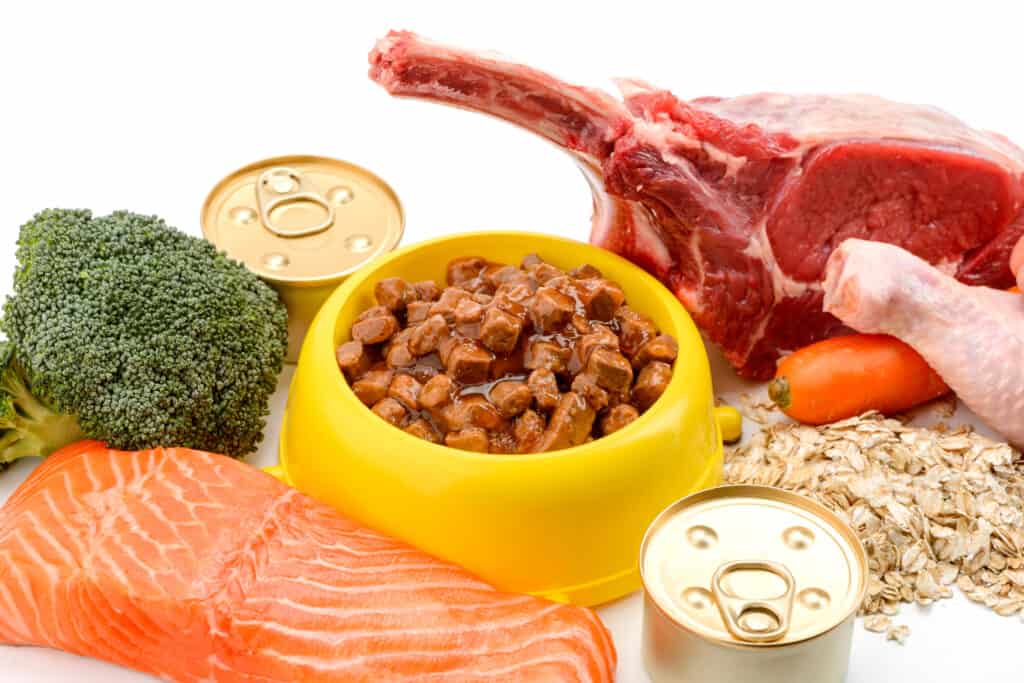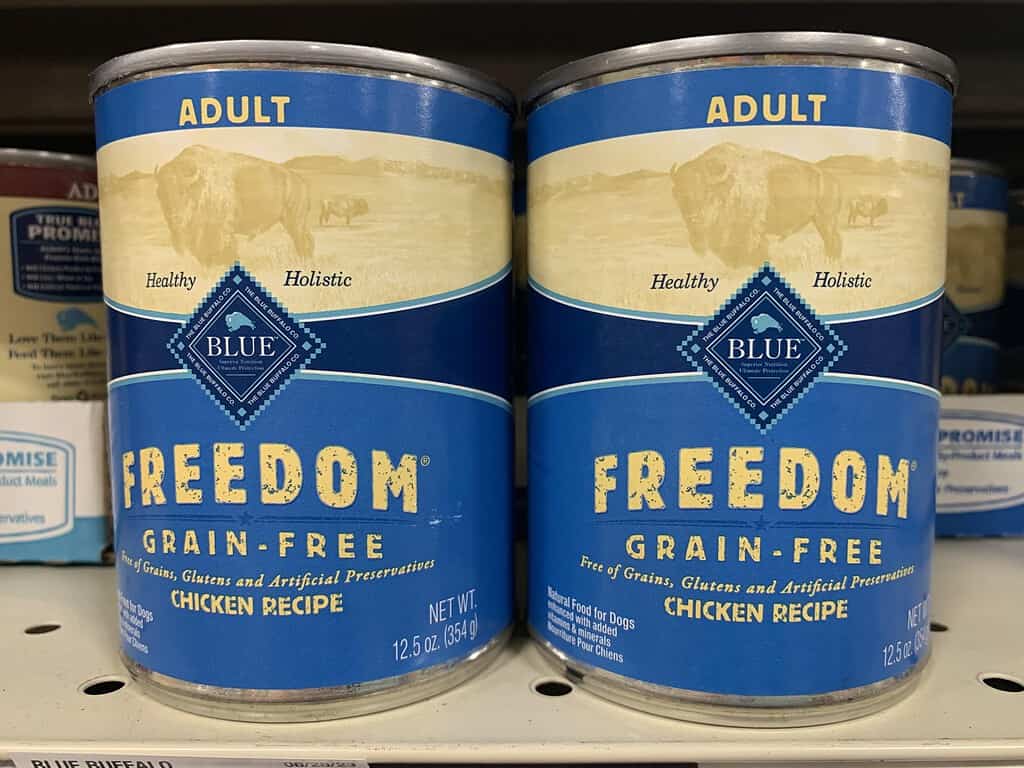
Dried dog food is readily available, but is it healthy for the animal?
©stockcreations/Shutterstock.com
Dog owners are faced with the task of choosing the best food for dogs. This is an important task because the food you give your pet will determine how healthy and happy they are. Unfortunately, there are a lot of myths and misconceptions about pet foods, and the manufacturer’s labels are hard to understand.
Pet owners are left with questions about the food they are giving their pets. Such as; is dried dog food bad for dogs, is wet food healthier than dry, and how I know which food is healthy. These are important questions and the following information will help answer them for you.
Dried Dog Food Ingredients

To choose the best food for your pet, you must read the ingredients on the label.
©Direct Photo Taken by Kristen Holder, Author AZ Animals – Original / License
The labels on dog food packaging can be confusing and are often misleading. The manufacturer creates an ingredient list and uses special terminology that the average person does not fully understand. Therefore people buy foods that they think are good for their pets, and in truth, the foods may be lacking in nutritional value.
A major concern with dog foods is the amount of minerals and trace minerals the food contains. Recent studies indicate that most dry dog foods contain more than the daily recommended limits of some minerals. Therefore, the food in the container is not a part of a balanced diet because the additives have increased the mineral content to a higher-than-average level.
Meat And Animal Products
The food you choose for your dog should comprise 50% meat products. This amount ensures the animal is receiving adequate amounts of protein in their diet. Common meats used in dog food are chicken, fish, lamb, beef, and turkey. There are rules concerning the wording used on labels that can help you better understand the ingredients.
Before you turn the food container over and start reading the ingredients look carefully at the name of the food. There is a lot of information hiding in the wording of the name. The Association of American Feed Control Officials (AAFCO) created four rules that manufacturers must adhere to concerning the names on their packages.
Rule 1 – The 95% Rule
If the name on the package lists a specific ingredient, such as Beef dog food, or salmon and chicken dog food, then the food must contain 95% of that ingredient. The remaining five percent is minerals and vitamins needed to balance the food nutritionally.
Rule 2 – The 25% Rule
If the food label says chicken dinner, turkey platter, beef entree, or fish stew, then the main ingredient accounts for 25% of the food. Therefore, the magic words platter, entree, stew, and dinner tell you that the meat content is lower in the product.
Rule 3 – The Word With
When the label has the word with, like dog food with beef, then the percentage of beef is only 3%. The word with means something added, so it does not reflect the main ingredient. This is tricky wording that many people do not understand. The foods you want to feed your pet are not the ones that contain the word with on their label.
Rule 4 – The Word Flavor
Flavor is a word used to indicate that the food does not contain the product but it tastes like it does. When the package says beef flavored, or chicken flavored, the percentage of actual beef or chicken can be zero. The foods you want to choose are not the ones that have flavor included in the name.
What Are By-products?
There is a myth that by-products on the label of pet foods refer to unedible animal parts like hooves, hair, or fillers that have no nutritional value. By-products are not fillers added to give the food weight or bulk.
Meat by-products are made from animal organs and pieces of fat and gristle that are trimmed away when human meat cuts are processed. Most of these by-products are from the liver, kidneys, spleen, and internal organs.
Meat Meal
Meat meal is the result of bones and connective tissues being cooked at a high temperature. The high temperature dries the water from the ingredients and makes them into a powder. This powder gives the dog food more flavor and adds some nutritional elements like vitamins and minerals.
Grains, Vegetables and Fruits
Dogs do not need grains to be healthy. However, they do need to take in the glucose that the grains in the food would provide. Fruits and vegetables added to the food add the glucose. If a food is labeled grain-free the glucose is produced by fruits and vegetables.
Grains are not bad for all dogs. The best dog foods that contain grains have a balanced mixture of grains to meat and fat products. Rice, wheat, and barley are common grains in pet foods. Some ingredients can cause allergic reactions.
Pros and Cons of Dried Dog Food

Dry food is good for the animal’s teeth.
©alex_ugalek/iStock via Getty Images
To determine the best food for dogs you have to weigh the pros and cons of the food.
| Pros | Cons |
| It is easy to store. | Does not taste as good as canned. |
| More convenient. | More preservatives. |
| More affordable. | Does not provide moisture. |
| Easier to serve. | Harder to chew. |
| Less messy. | May have more carbohydrates. |
| Less water so it provides more energy. |
How To Choose The Best Dog Food For Your Pet

Choosing your dog’s food type and brand is an important decision.
©Yuriy Golub/Shutterstock.com
The right food for your pet is the food that supports the needs of the individual dog. Food choices for animals must be made after considering the animal. their lifestyle, their age. Also, the preference of the dog needs to be considered.
Choose Food According To Dog Age

English cocker spaniel
puppy eating dog food.
©Switlana Sonyashna/Shutterstock.com
Puppies Up To 18 Months
From the time puppies are born, they are growing rapidly and they have higher nutritional needs than adult or senior animals do. The best dog foods for puppies include 0.7 to 1.7% calcium for bone growth. They also need food that is 22 to 32% protein, 20% carbohydrates that are easy to digest, and 17 – 25% fat.
Adult Up To 12 Years
When a dog is mature their dietary needs change. An adult dog needs food that contains 10% protein, 50% carbohydrates for energy, 2.5 to 4.5% fiber, and 5.5% fat. This combination, along with essential minerals and vitamins will allow the adult dog to be healthy and feel satisfied when they eat.
Follow the guidelines on the package for the amount of food to give your animal, but also consider the animal. If your dog is very active then they can eat more food without becoming obese. If your dog stays inside most of the time and does not get much exercise then they need to eat smaller food portions.
Senior Dogs 12 Years and Older
Dogs are classified as seniors at different ages.
| Small Breeds | Medium Breeds | Large Breeds |
| 11- 12 years | 10 Years | 7 Years |
The discrepancy in when a dog is considered a senior is based on the average life expectancy of the dog breed. Subsequentially, your senior pet does not need to change their foods. Reasons to switch an animal to senior foods include:
- Also when the animal becomes sedentary and needs fewer carbohydrates in their food.
- when your pet starts to have difficulty chewing the dry food.
- if the dog becomes picky and no longer likes the food.
Things You Can Add To Dry Dog Food To Improve Nutrition
If you choose to feed your dog dry food, but worry that they need more nutritional value, you can add things to the ingredients to create the balance that you want. By adding different items to the food you can increase the hydration it provides, increase the protein, or the carbohydrates. Each dog is unique and their diet should reflect their individual needs, likes, and lifestyles. Some things to add to dry food are:
- Vegetables cooked or finely chopped. Vegetables increase the carbohydrate count and the fiber of the food without adding too many extra calories.
- Berries, apple pieces, pears, bananas, and similar fruits are high in antioxidants. Dogs like watermelons and other melons too. Do not add raisins or grapes to the food because they cause kidney failure in animals.
- Eggs add protein to the food. Scrambled or fried eggs are stirred into their food. Boiled eggs are great however, no raw eggs.
- Sardines add the Omega-3 fatty acids that are healthy. Sardines packed in water the fish supplement is low in calories and high in flavor.
Is Wet a Better Than Dried?

Blue
Buffalo
is grain-free but is it healthier?
©Kristen Holder, Author AZ Animals, Photo Taken Directly – Original / License
Wet food is another dog food option that is readily available. Is wet food the best choice for dogs? Canned foods do provide more moisture so they offer more hydration. However, the ingredients in the canned food are not necessarily healthier choices for your animal.
Ingredients used in the canned products are similar to ingredients found in the dry versions. You have to decide whether you like canned better than dry, or if you like to mix the two types and serve both.
Pros and Cons of Canned Food
| Pros | Cons |
| More palatible. | More expensive |
| Has greater moisture content. | Harder to serve |
| More palatable. | Odor is offensive |
| Less carbohydrates | Spoils quickly when left out |
| Can reduce obesity risks | Spoils quickly left out |
| Creates more waste to dispose of. | |
| Has higher fat content. | |
| does not prevent tartar build-up | |
| Cans may be lined with Bisphenol-A (BPA) | |
| does not support the high-energy needs for active dogs |
FAQs
Which brand of dry dog food is best?
There is no perfect answer to this question. The right food is determined by the dog, its lifestyle, age, and nutritional needs. Choosing the perfect food for your pet requires you to know their individual nutritional needs.
Does dog food have an expiration date?
All dog food has an expiration date printed on the label. Canned dog food has a shelf life expectancy of two years. Dried dog food has a shelf life expectancy between 12 and 18 months. After the expiration day, the food is stale and loses nutritional value.
What is 80/20 dog food?
If the dog food you are looking at has 80/20 on the label it contains 80% animal products, 20% vegetable or fruit products, and 0% grain.
The photo featured at the top of this post is © stockcreations/Shutterstock.com
Ready to discover the top 10 cutest dog breeds in the entire world?
How about the fastest dogs, the largest dogs and those that are -- quite frankly -- just the kindest dogs on the planet? Each day, AZ Animals sends out lists just like this to our thousands of email subscribers. And the best part? It's FREE. Join today by entering your email below.
Thank you for reading! Have some feedback for us? Contact the AZ Animals editorial team.







